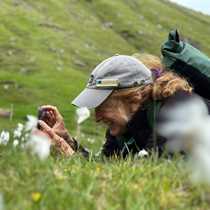Los Islotes Java
As coffee on the Sea Bird percolated, a different brew came to a briny boil around the rocky islet of Los Islotes. From a Zodiac, Jack dipped his coffee-less cup into the churning waters and came up with a rich broth of euphausids, a shrimp like “java” du jour for a food chain that cumulated in plunge diving pelicans and boobies. Fish balls foamed like whipped cream topped double lattes along the surface of the sea as we maneuvered our Zodiac’s around the guano frosted islet. We came back for a second investigation, this time goggle-eyed and flipper footed, ready to stare eye to eye and nose to whisker with California sea lions. One young sea lion decided to do its own investigations, and after several tries, landed on the pontoon of a Zodiac. It stretched out lizard like on the cozy rubber surface, briefly basked in the warmth of the morning sun and, seemingly bored with the terrestrial sights of the morning, splashed back into its fish and flippered-friend filled watery realm. We share this whiskered explorer with you in today’s photograph.
We have explored Mexico’s precious resource, the Gulf of California, and its island treasures. Why do we work so hard to save such places? The World Wildlife Fund has phrased it succinctly; the motivation to conserve, to educate and to foster an appreciation for such wild places and their biota is to ultimately “leave our children a living planet.”
Amongst our intrepid explorers this week have been children, those who are to inherit the Gulf’s heirloom jewels, the islands we all consider so precious that we want to coddle and hold them safe from harm. Shared here is a reflection from a young lady’s discoveries and adventures.
The Sea Bird
As we sail across the Sea of Cortez, with a wonderful breeze flying over our heads, out of nowhere comes a gigantic blue whale, with the mist going over the top of his tail. His flipper goes high fluking and all, when another one breeches and lets out a great call! They quick swim away but replaced with a sperm! Oh the things that we see, oh the things that we learn. To meet it comes a fin whale, second largest of all splashing and splashing so close to our wall! The water drops flying on our hands, as we reach towards the beautiful splendid sand covered beach. Then an elegant tern flying so close to our stern, twirled around which very surprisingly did not make a sound. Then very quickly we immediately found a large group of dolphins swimming in the seas, revealing their very small brown looking babies. We watched them dash and we watched them turn, all so close to the white boat’s stern. Towards the end of the day, as the sun slowly sets, we remember all the things that happened that day.
By Annie Ela, age 9
As coffee on the Sea Bird percolated, a different brew came to a briny boil around the rocky islet of Los Islotes. From a Zodiac, Jack dipped his coffee-less cup into the churning waters and came up with a rich broth of euphausids, a shrimp like “java” du jour for a food chain that cumulated in plunge diving pelicans and boobies. Fish balls foamed like whipped cream topped double lattes along the surface of the sea as we maneuvered our Zodiac’s around the guano frosted islet. We came back for a second investigation, this time goggle-eyed and flipper footed, ready to stare eye to eye and nose to whisker with California sea lions. One young sea lion decided to do its own investigations, and after several tries, landed on the pontoon of a Zodiac. It stretched out lizard like on the cozy rubber surface, briefly basked in the warmth of the morning sun and, seemingly bored with the terrestrial sights of the morning, splashed back into its fish and flippered-friend filled watery realm. We share this whiskered explorer with you in today’s photograph.
We have explored Mexico’s precious resource, the Gulf of California, and its island treasures. Why do we work so hard to save such places? The World Wildlife Fund has phrased it succinctly; the motivation to conserve, to educate and to foster an appreciation for such wild places and their biota is to ultimately “leave our children a living planet.”
Amongst our intrepid explorers this week have been children, those who are to inherit the Gulf’s heirloom jewels, the islands we all consider so precious that we want to coddle and hold them safe from harm. Shared here is a reflection from a young lady’s discoveries and adventures.
The Sea Bird
As we sail across the Sea of Cortez, with a wonderful breeze flying over our heads, out of nowhere comes a gigantic blue whale, with the mist going over the top of his tail. His flipper goes high fluking and all, when another one breeches and lets out a great call! They quick swim away but replaced with a sperm! Oh the things that we see, oh the things that we learn. To meet it comes a fin whale, second largest of all splashing and splashing so close to our wall! The water drops flying on our hands, as we reach towards the beautiful splendid sand covered beach. Then an elegant tern flying so close to our stern, twirled around which very surprisingly did not make a sound. Then very quickly we immediately found a large group of dolphins swimming in the seas, revealing their very small brown looking babies. We watched them dash and we watched them turn, all so close to the white boat’s stern. Towards the end of the day, as the sun slowly sets, we remember all the things that happened that day.
By Annie Ela, age 9




